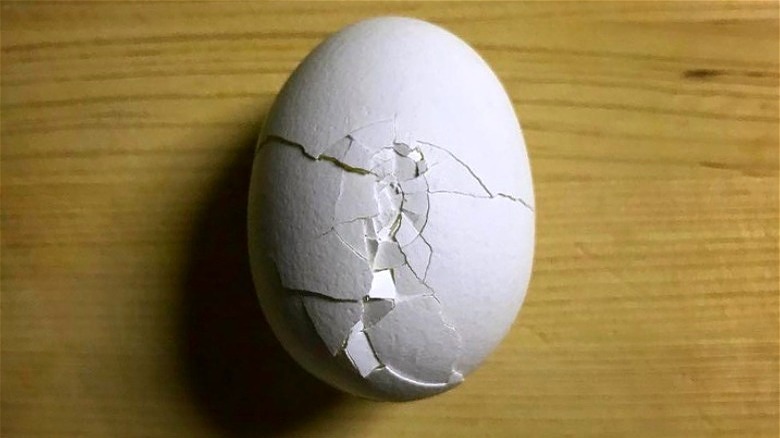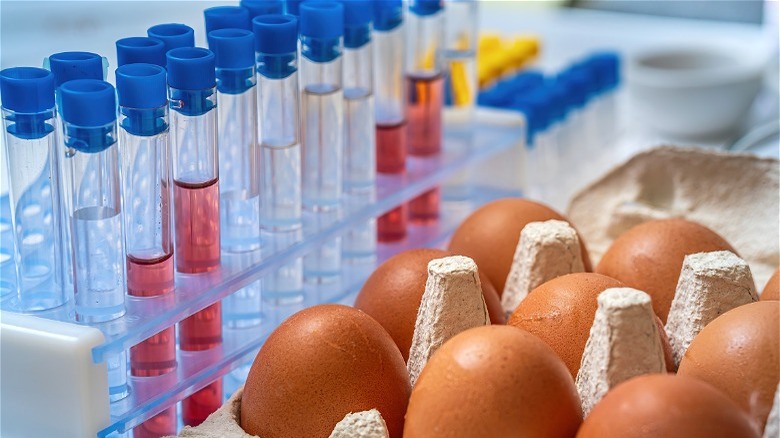Why You Should Never Cook With Broken Eggs
Before exploring the 101 ways to cook an egg, you might want to ensure the eggs you have on hand are safe to eat. Knowing what to look for and taking the necessary steps to keep store-bought eggs fresh up until their long-awaited debut on your breakfast plate is critical to keeping your belly happy.
According to the FDA, purchased eggs should not only be stored in a refrigerator at or below 40 degrees Fahrenheit but they should also be used within three weeks of purchase. Testing the freshness of an egg alone can be done with the classic float test. The USDA claims an egg floats when the inner air cell becomes bigger, indicating an older egg. Yet, just because an egg is old doesn't mean it can't be eaten.
If you're not sure how long that carton of eggs has been sitting in your refrigerator, there are still ways to tell if the contents are safe to eat. Healthline advises consumers to check expiration dates and when in doubt, look for signs of discoloration after cracking an egg's contents into a bowl. Additionally, the sniff test also works, per Healthline. But what happens when you go to make your first meal of the day and realize there are already cracks in some of your eggs? Unfortunately, there are more risks to eating cracked eggs than you might assume.
Cracked eggs are typically off-limits
One major reason why eggs with cracks are typically avoided is due to the increased risk of Salmonella poisoning. The USDA advises that you should never buy cracked eggs due to potential bacteria seeping through the shell. This is also why the FDA recommends that you should open cartons in-store before purchasing. The USDA discloses that if eggs break in transit, you should fully crack the eggs into a bowl, cover them tightly, and refrigerate them. The Egg Safety Center recommends using the covered eggs within a two-day period, fully cooking both white and yolk before eating.
While this seems simple enough, Eat or Toss claims cracked eggs signify a bacterial invasion only when an egg's membrane is broken in addition to the shell. If an egg has a simple "hairline crack" and you're sure the membrane is intact, make sure to cook the egg thoroughly before eating, says Deana R. Jones, a research food technologist at the U.S. National Poultry Research Center, via Eat or Toss. But deciphering a broken membrane behind a cracked shell often proves to be a guessing game. When in doubt, Jones advises that you should throw away suspect eggs since "a crack in an eggshell is like the Grand Canyon" for the spread of bacteria.
The dangers of eating contaminated eggs
Salmonella is a type of bacteria that laying hens and other birds can carry, and the CDC claims that these germs can be passed from hens to eggs through fecal matter or from an infection within the hen itself. Consuming undercooked eggs may also cause possible infection, says the CDC. Salmonella infection causes upset stomach and diarrhea up to 72 hours after infected eggs are consumed, per Mayo Clinic. According to Food Network, unlike the U.K. where all laying hens are vaccinated, vaccination is optional in the U.S., so American agencies focus their attention on egg handling and safe transportation to prevent Salmonella infections.
While there are other foods linked to salmonella, The Washington Post noted in 2009 that 142,000 Americans each year had been infected with egg-induced salmonella poisoning. The high number of incidences spurred the USDA to enact the "Egg Safety Final Rule" which went into effect that same year, per Food Safety News. In the ruling, the USDA outlined the strict implementation of safe handling and refrigeration in poultry laying facilities with over 3,000 egg-producing hens, with a hope to reduce roughly 80,000 infections.
While no federal study has been able to provide statistical data on salmonella in eggs before and after the ruling, staying educated on proper egg handling remains vital to decrease your chances of infection.


